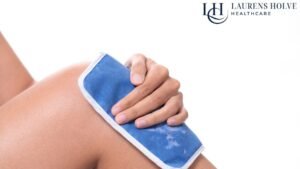Let me paint you a quick picture: last spring, I tried racing my niece up the garden, only to discover my left knee had rather strong opinions about sudden acceleration. If you’ve ever been caught out by a cranky arthritic knee, you’ll know it’s less about the drama and more about the everyday grind—the creaks, the little stabs, the awkward shuffles. This post isn’t about miracle cures or fancy gadgets—instead, it’s five practical, tried (by real people!), and sometimes quirky tips for keeping your knees in the game. Ready for a fresh take?
Water Isn’t Just For Ducks: Embracing Aquatic Exercise For Knee Arthritis
If you’re seeking relief from knee arthritis, you might be surprised to learn that water-based activities are among the most effective low-impact aerobic exercises available. Whether you’re new to knee pain or have been managing arthritis for years, aquatic exercise could be your ticket to moving more freely, with less discomfort.
Why Water Works Wonders for Arthritic Knees
Water’s natural buoyancy supports your body weight, which means your knees bear far less pressure compared to land-based workouts. In fact, studies show that water-based exercise can reduce knee joint load by up to 50% compared to traditional routines. This makes swimming and water aerobics ideal knee arthritis exercises for those with even severe symptoms.
Swimming for Knee Arthritis: More Than Just Laps
Swimming for knee arthritis isn’t just about doing endless lengths. The water’s support allows you to move your legs through a full range of motion without the jarring impact of walking or jogging. This gentle movement helps maintain flexibility and can even improve your joint’s mobility over time. The swimming benefits extend to muscle strengthening, as the water provides gentle resistance with every stroke or kick.
Buoyancy reduces knee stress – letting you move pain-free
Improved range of motion – water supports and guides your movements
Muscle strengthening – resistance from water tones muscles without strain
Water Aerobics: Gentle Resistance, Real Results
If swimming laps isn’t your style, water aerobics offers a social and effective alternative. These classes use the water’s resistance to help you build strength and stability around your knee, but without the harsh impact of land-based exercise. Movements are often slow and controlled, making them suitable for all fitness levels and stages of arthritis.
Gentle resistance strengthens knee-supporting muscles
Low-impact exercises reduce risk of further joint damage
Classes often foster a friendly, supportive environment
Making the Pool Less Intimidating
If the idea of heading to the pool feels daunting, remember: you don’t have to swim like an Olympian to benefit. Picture yourself floating along, chatting with a mate, or simply walking through the water. Many find that exercise doesn’t have to be dull or solitary—water-based sessions can be as relaxed or as structured as you like.
“Water-based exercise is not only safe for those with knee arthritis, but it’s also enjoyable and highly recommended at any stage of the condition.”
Getting Started with Low-Impact Exercises
Speak with your Osteopath or GP before starting any new exercise routine. Most pools offer beginner-friendly sessions or arthritis-specific classes, making it easy to get started with low-impact knee arthritis exercises that suit your needs and comfort level.
Quad Sets and Seated Marches: Rediscovering Your Inner Muscle (It’s There, Honestly)
When it comes to exercises for arthritic knees, simplicity is often the key to success. You do not need a gym membership or fancy equipment—just a chair, a bit of patience, and a willingness to reconnect with muscles you might have forgotten you had. Two of the most effective, low-impact moves for knee arthritis are the Quad Set Exercise and the Seated Hip March. These are not just for athletes or physios; they are practical tools for anyone looking to strengthen knee muscles and improve daily comfort.
Why Quadriceps Strengthening Matters
Your quadriceps—the group of muscles at the front of your thigh—play a crucial role in stabilising the knee joint. Research consistently shows that stronger quads mean less knee pain and better function. In fact, targeted quadriceps strengthening can help slow the progression of arthritis and reduce the risk of falls. The best part? You can start right from your favourite chair.
How to Do a Quad Set Exercise
Sit comfortably with your legs straight out in front of you (on a bed or firm sofa works well).
Tighten the muscles at the front of your thigh, as if you’re trying to press the back of your knee down into the surface.
Hold for a slow count of five, then relax.
Repeat 10 times, aiming for two or three sets a day.
This ‘tense and release’ move is gentle, yet it directly targets the muscles that support your knee. Even on sore days, the quad set exercise is usually manageable and can help maintain muscle tone without aggravating your symptoms.
Seated Hip March: Support Up the Chain
While the quads are vital, the muscles around your hips and glutes also play a big part in knee stability. The Seated Hip March is a simple way to wake up these supporting muscles:
Sit upright in a sturdy chair, feet flat on the floor.
Lift one knee towards your chest as high as comfortable, then lower it back down.
Alternate legs, aiming for 10 lifts on each side.
This move not only strengthens your hips and thighs but also encourages better balance and joint support. Seated hip marches are especially useful for those days when standing exercises feel too much.
Making It Work for You
Progress with these exercises for knee arthritis may feel slow at first, but consistency is key. Even five minutes a day—perhaps during TV adverts or at half-time, as my uncle does—can make a noticeable difference over time. Remember, it’s not about perfection, but about giving your muscles a chance to do their job in supporting your knee.
“Strong quads reduce pain and help maintain knee function. Seated hip marches support knee stability.”
By focusing on these straightforward moves, you are investing in the long-term health and comfort of your knees, one small step at a time.
When The Couch Beckons: Gentle Movement Matters More Than Grand Gestures
When knee arthritis flares up, the temptation to stay put on the sofa can be strong. Yet, research and experience both show that gentle movement—not grand gestures—makes the real difference in managing your symptoms. If you think you need to embark on marathon walks or join a gym to help your knees, think again. The most effective approach is often the simplest: short, regular, low-impact exercises that keep your joints moving without overloading them.
Walking for Knee Arthritis: Short and Steady Wins the Race
Walking is one of the most accessible and beneficial activities for knee arthritis. The key is to keep it short and steady. For example, a neighbour of mine, who struggles with knee pain, does laps around her living room on rainy days. This simple routine keeps her joints moving and her spirits up. You do not need to walk for miles; even 10 minutes a day can make a difference. According to experts, 10–30 minutes of low-impact exercise, three to five times per week, helps maintain flexibility and reduces pain. The consistency of these short walks is far more valuable than occasional, strenuous efforts.
Stationary Biking: Dust Off That Exercise Bike
If you have a stationary bike gathering dust, now is the time to put it to use. Stationary biking offers smooth, controlled movement that is gentle on the knees, making it an excellent choice for those with arthritis. Unlike outdoor cycling, you can easily adjust the resistance and duration to suit your comfort level. Even a brief session—just 10 minutes—can help maintain your range of motion and support knee health without causing undue strain.
Consistency Beats Heroics: The Power of Routine
It is easy to fall into the trap of doing too much on a ‘good’ day, only to pay for it later. The truth is, consistency beats heroics every time. A daily routine of low-impact exercises—such as walking, stationary biking, or simple physical therapy exercises—is far more effective than sporadic bursts of intense activity. This approach helps keep your knees limber, protects your range of motion, and reduces the risk of setbacks caused by overdoing it.
Low-impact activities like walking and stationary biking are ideal during joint pain flares.
Short, frequent sessions keep your knees moving and help maintain joint health.
Overdoing exercise can lead to increased pain and stiffness—moderation is key.
“Gentle, regular movement is the cornerstone of knee arthritis care. Ten minutes a day, done consistently, is more valuable than occasional, strenuous efforts.”
Remember, staying active does not mean pushing through pain. Listen to your body, choose activities you enjoy, and focus on maintaining a gentle, consistent routine. Over time, these small steps add up to significant improvements in comfort and mobility.
Wildcard Wisdom: Embracing The Unexpected (From Heat Packs To Breakfast Choices)
When it comes to knee arthritis treatment options, it’s easy to focus on the obvious: exercise, medication, or perhaps surgery. Yet, some of the most effective pain relief strategies are surprisingly simple and often overlooked. Embracing these “wildcard” approaches—like heat and ice therapy, knee braces for arthritis, and even mindful breakfast choices—can make a meaningful difference to your daily comfort and mobility.
Let’s start with thermal therapies. Applying a warm wheat bag or heat pack to your arthritic knee before you get moving can be a game-changer. The warmth helps to relax stiff muscles, increase blood flow, and prepare your joint for the day ahead. This small act can make those first steps less daunting, especially on chilly mornings. After activity, when your knee feels sore or inflamed, an ice pack can be your best friend. Cooling the area helps to reduce swelling and soothe discomfort, making recovery quicker and less painful. These heat and ice therapy options are not only practical but also affordable, with most products ranging from £10 to £20 depending on quality and features.
Another unexpected ally in your toolkit is the knee brace. On days when your knee feels particularly unstable or “wobbly”, or if you’re venturing out for a walk on uneven ground, a well-fitted knee brace can offer instant support. Modern arthritis knee support products are discreet, comfortable, and easy to use. They provide gentle compression and stability, helping you move with greater confidence and less pain. Braces are especially useful for those moments when you need a little extra reassurance—no need to wait for a flare-up to strike before reaching for one.
Perhaps most surprising of all is the role your diet can play in managing arthritis symptoms. While it might seem unrelated, your breakfast choices can influence inflammation throughout the day. For example, adding a handful of berries to your morning porridge or yoghurt introduces a dose of antioxidants, which are known to help reduce joint inflammation over time. Small dietary tweaks—such as incorporating more oily fish, nuts, or leafy greens—can complement your physical strategies and enhance overall knee health. These dietary recommendations are easy to adopt and can be tailored to your tastes and lifestyle.
I have written previous blogs about foods and arthritis here:
Best foods for arthritis: https://holve-osteopaths.co.uk/best-foods-for-osteoarthritis/
Incorporating these non-exercise strategies into your routine rounds out your approach to knee arthritis care. Heat and ice therapy, knee braces, and mindful eating are not just add-ons; they are essential components of a comprehensive pain relief strategy. By embracing the unexpected and being open to trying new things, you give yourself the best chance of staying active, comfortable, and in control of your knee health. Remember, there’s no magic required—just a willingness to explore what works best for you.
In conclusion, managing an arthritic knee is about more than just medication or exercise. It’s about weaving together a variety of practical, everyday solutions—some expected, some delightfully surprising. With a little wildcard wisdom, you can face each day with greater confidence and less pain, making the most of every step.





